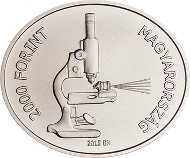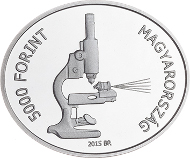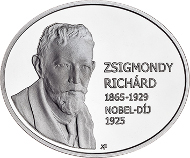May 7, 2015 – As part of the collector coin series honouring Hungarian Nobel Prize winners, the Magyar Nemzeti Bank is issuing a 5000-forint silver and a 2000-forint non-ferrous coin, marking 150th birthday of Richárd Zsigmondy and 90th anniversary of receiving the Nobel Prize.
Hungary / 2015 / 2,000 forint / Design: Fanni Király.
The coin was designed by Fanni Király and the front depicts an ultramicroscope receiving light rays from the side. The obverse bears a portrait of Richárd Zsigmondy.
Richárd Zsigmondy (1865-1929)
Born on 1 April 1865 in Vienna as the child of a famous Hungarian family, the chemist Zsigmondy was the founder and one of the key researchers of the field of colloidal chemistry. His father, Adolf Zsigmondy, was a well-known dentist, scientist and inventor. His mother, Irma Szakmáry, was a poet, who raised her son to love nature and the arts. His interest in science quickly became apparent: even as a child he conducted experiments in the laboratory built with his father’s help.
Hungary / 2015 / 5,000 forint / Design: Fanni Király.
After obtaining a degree from the Vienna Medical University, he continued studying at the Technical University of Vienna. He was awarded a PhD in organic chemistry in 1889 in Munich and then studied physics as an analyst for Professor Kundt at the University of Berlin. It was at that time he began his research on colloids (dispersion systems with particles between 1 nm and 500 nm in at least one dimension), including metal hydrosols and gold hydrosols. From 1893 he taught in Graz, while also studying colours for glass, focusing in particular on the gold hydrosol called Purple of Cassius. He continued his work from 1897 in Jena, Germany, as a scientist working for the Schott glass factory. Amongst other things, he invented Jena “milk glass” (which remains popular today) while working there and his studies contributed to the manufacture of coloured porcelains. In 1903, working with H. Siedentopf, a physicist from the engineering and optics shop of the Zeiss factory, he invented the ultramicroscope, functioning on the basis of the Tyndall effect (scattering of light by particles in a fine suspension). He continued developing this invention into the slit-ultramicroscope in 1912. From 1907 until his retirement he was a professor at the Institute of Inorganic Chemistry at the University of Göttingen. He also invented the membrane filter (1918), which was later used in medical biology applications, and the ultrafilter (1929), which allowed for the separation of bacteria and viruses from each other or their media. He was awarded the Nobel Prize for Chemistry in 1925 “for his demonstration of the heterogenous nature of colloid solutions and for the methods he used, which have since become fundamental in modern colloid chemistry”. He died on 23 September 1929 in Göttingen.
The essence of his discoveries was that when colloid solutions are illuminated from the side the nanoparticles contained therein which cannot be seen in normal lighting conditions can be demonstrated, and he also showed that colloid systems form a transition between suspensions and solutions. The significance of colloids is underlined by the fact that without the knowledge of such it would have been impossible for example to create light foams, breathable artificial leather, highly efficient washing detergents, concentrated food products, fast-drying paints, water-resistant coatings, contact glues and many other products with new characteristics thanks to nano-technology.
You can read Richard Zsigmondy’s Nobel Lecture here.
The website of the Magyar Nemzeti Bank you may find here.








